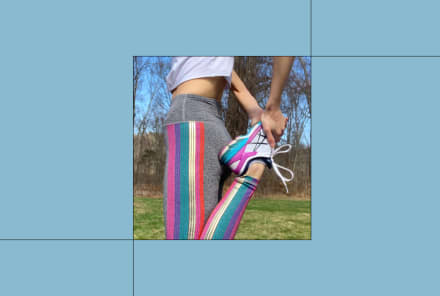Advertisement
I'm A Professional Pole Dancer: Here Are 10 Things I Wish Everyone Knew About Pole Dancing

I started pole dancing after seeing it performed at a live event in New York City. The women mystified me with their grace and strength, and I wanted to learn how to move like them. After my first class, however, I found that pole dancing was hard—every muscle in my body ached for days.
After much practice and training, I'm now proud to say I'm a professional pole dancer and aerialist. But it wasn't easy. Here are 10 things people might not know about this fitness form.
Most pole dancers, regardless of age, are in the best shape of their lives.
Pole dancing is a full-body workout. It is resistance training and cardio in one, and flexibility is improved as well. Pole dancers perform acrobatic tricks either suspending their weight or propelling it around a metal pole. The simple act of climbing a pole is an incredible display of strength. It is no surprise, then, that most pole dancers insist they have never looked or felt better.
Natasha Wang, a world champion pole dancer, didn’t even start the exercise until age 29. Greta Pontarelli is a champion pole dancer at age 63—and she only began a few years ago!
There are many different types of pole dancing.
Pole dancing is extremely versatile. There are three main branches: sport, art, and sexy:
- In sport, you have the serious athletes performing difficult tricks and displaying unfathomable muscular strength. (Some have even petitioned for pole to become an Olympic event!)
- Then there are also those who embrace the artistic side pole has to offer. The simplicity of a vertical apparatus like the pole is appealing in that there is no shortage of creativity—so many stories can be told. Many pole dancers perform barefoot and have been known to incorporate modern dance, props and costumes into their routines.
- Finally the sexy side of pole is still practiced by many. These dancers usually wear heels and favor more sensual, erotic movement.
Although there is some debate within the community about which direction pole is heading, all three forms flourish, and many pole dancers enjoy all styles. There is something for everyone!
You need your skin exposed to grip the pole.
Pole dancers must have their legs, arms and stomachs exposed to safely grip the pole. There are some grounded spins, poses, and floor work that can be performed while wearing pants, but in order to perform more advanced moves, we must have the proper amount of skin exposure.
At first, the idea of working out in a sports bra and tiny shorts may seem intimidating. But most new pole dancers quickly discover they are having too much fun to worry about what they look like. Their focus shifts instead to what they can accomplish—a freeing notion, really, that can help build confidence.
It can be dangerous without proper training.
Although pole dancing is fun, it is a serious athletic endeavor that should not be taken lightly. Some people do not realize how challenging pole can be on a first attempt (re: every muscle in my body ached for days). In addition to bruises, pole dancers can experience shoulder or back pain with improper technique or overtraining.
You should always learn from a certified instructor. If training from home, take time properly installing your home pole according to manufacturer instructions and vetting a reputable online learning platform. If you're too eager to flip upside down, it can be especially dangerous and can lead to injury.
That said, I encourage everyone interested in pole dancing to go through gradually progressive training with a professional.
Men can (and do!) pole dance.
The number of men pole dancing continues to grow every year. There are men’s divisions in competitions now, and I see more men joining classes I take or teach than ever before.
Men’s natural inclination toward upper body strength makes them ideal candidates for the sport. There are many ancient forms of pole dancing such as Mallakhamb, a traditional Indian sport where the practitioner performs yoga postures on a wooden pole—and has actually been performed exclusively by men throughout history.
“Not having upper body strength” is not an excuse to avoid it.
I understand that you may be nervous to try pole dancing. Maybe you don’t feel you are at your ideal weight, or you think you have no rhythm, or you think you're too old. But I encourage you to stop creating roadblocks for yourself. The best way to get better at something is to work on it! Every athletic journey requires a first courageous step. You'll grow over time as you build skills, strength and body awareness. Overcoming feats is part of what's so inspiring and empowering about pole.
Whether you’re uncoordinated and can’t lift your own body weight or you're an athlete with gymnastic capabilities, there is always a new trick or transition to learn with pole dancing. The process of growth never ends, and the possibilities can be as creative as your imagination allows them to be.
It’s not always so sexy.
Pole dancing is not always as overtly sexual as people may believe. The process of training is often full of awkward and unglamorous moments. Many of us end up with bruises, burns, and scrapes from trying new moves. And although we may wear sports bras and tiny shorts when performing, most dancers opt for comfort over fashion in between training sessions.
But it can be very sexy.
The seductive allure of pole dancing still remains steadfast. There was a period of time when pole dancing first became mainstream where many pole dancers sought to distance its association with strip clubs. They felt this link delegitimized efforts to be taken seriously. The community has since evolved to understand this denial as a form of appropriation and recognizes with respect the roots this art form holds in exotic dance.
While many styles of dance and movement currently inspire modern pole dancing, the kind we practice today would not exist without strippers. Many of the first informal pole dancing classes in the US took place in strip clubs and many of the first pole studios in the US were founded by strippers who became small business owners and entrepreneurs.
The community is very tight-knit.
Because what we do is still considered taboo by many, there is a unique closeness that bonds us together. There are pole dancers of all professions, ethnicities, religions, cultures, sizes, and ages. I have friends all over the world because of pole dancing, and I have friends who have been able to travel the world because of it.
We support each other through learning new moves. We share each other’s videos, and we watch each other perform. This shared interest bonds us with a special understanding, just like any other team sport.
Pole dancing can be emotionally healing.
This is one of the biggest reasons I've stuck with pole dancing as long as I have. The physical benefits are great, but the feeling you get from mastering a move or expressing a particular emotion is indescribable. For example, when I am able to assist a student without any fitness background in their first pole climb, it is an honor to witness their feeling of accomplishment and resulting boost in self-confidence.
You can dance out any emotion in class, whether joyful, angry, or sad. The combination of athletic skill and artistic influence makes it unique to any other form of dance or sport. To me, it is both dance and sport woven together into one beautiful, athletic art form.
Watch Next
Enjoy some of our favorite clips from classes
Enjoy some of our favorite clips from classes
What Is Meditation?
Mindfulness/Spirituality | Light Watkins
Box Breathing
Mindfulness/Spirituality | Gwen Dittmar
What Breathwork Can Address
Mindfulness/Spirituality | Gwen Dittmar
The 8 Limbs of Yoga - What is Asana?
Yoga | Caley Alyssa
Two Standing Postures to Open Up Tight Hips
Yoga | Caley Alyssa
How Plants Can Optimize Athletic Performance
Nutrition | Rich Roll
What to Eat Before a Workout
Nutrition | Rich Roll
How Ayurveda Helps Us Navigate Modern Life
Nutrition | Sahara Rose
Messages About Love & Relationships
Love & Relationships | Esther Perel
Love Languages
Love & Relationships | Esther Perel











